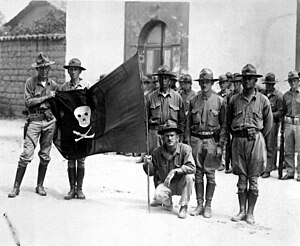US Occupation of Nicaragua
| United States occupation of Nicaragua | |||||||
|---|---|---|---|---|---|---|---|
| Part of the Banana Wars | |||||||
 United States Marines with the captured flag of Augusto César Sandino in 1932 |
|||||||
|
|||||||
| Belligerents | |||||||
|
|
(1927–1933) |
||||||
| Commanders and leaders | |||||||
|
|
|
||||||
| Casualties and losses | |||||||
|
First occupation (1912–1925): 5 American Marines and 2 American sailors killed (all in 1912) 16 American Marines wounded (all in 1912) Second occupation (1926–1933): 136 American Marines dead (32 killed-in-action, 15 died of battle wounds, and 5 murdered by mutinous Nicaraguan National Guardsmen) 75 Nicaraguan National Guardsmen killed |
First occupation (1912–1925): unknown Second occupation (1926–1933): 1,115 "bandits" (presumably Sandinistas) killed (this number may have been inflated) |
||||||
American victory;
Nicaragua occupied
The United States occupation of Nicaragua from 1912 to 1933 was part of the Banana Wars, when the US military forcefully intervened in various Latin American countries from 1898 to 1934. The formal occupation began in 1912, even though there were various other assaults by the U.S. in Nicaragua throughout this period. American military interventions in Nicaragua were designed to stop any other nation except the United States of America from building a Nicaraguan Canal.
Nicaragua assumed a quasi-protectorate status under the 1916 Bryan–Chamorro Treaty. But with the onset of the Great Depression and Augusto C. Sandino's Nicaraguan guerrilla troops fighting back against U.S. troops, it became too costly for the U.S. government and a withdrawal was ordered in 1933.
In 1909 Nicaraguan President José Santos Zelaya of the Liberal Party faced opposition from the Conservative Party, led by governor Juan José Estrada of Bluefields who received support from the U.S. government. The United States had limited military presence in Nicaragua, having only one patrolling U.S. Navy ship off the coast of Bluefields, in order to protect the lives and interests of American citizens who lived there. The Conservative Party sought to overthrow Zelaya which led to Estrada's rebellion in December 1909. Two Americans, Leonard Groce and Lee Roy Cannon, were captured and indicted for allegedly joining the rebellion and the laying of mines. Zelaya ordered the execution of the two Americans, which severed U.S. relations.
...
Wikipedia
